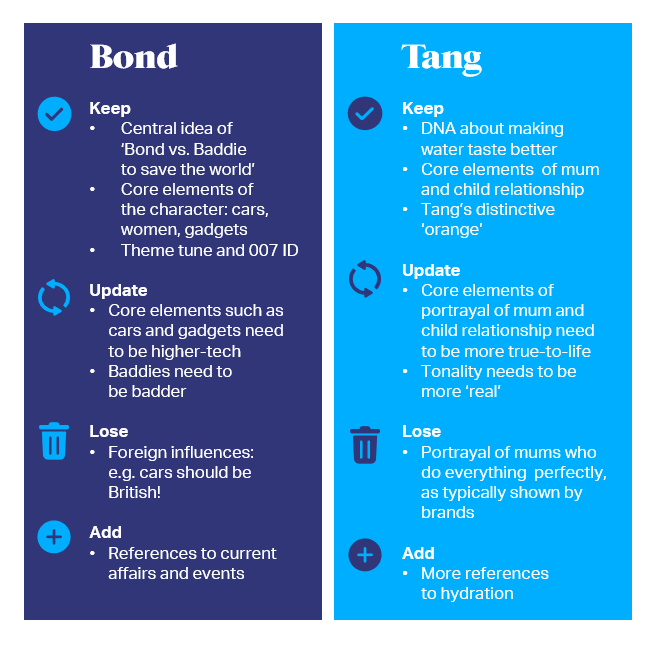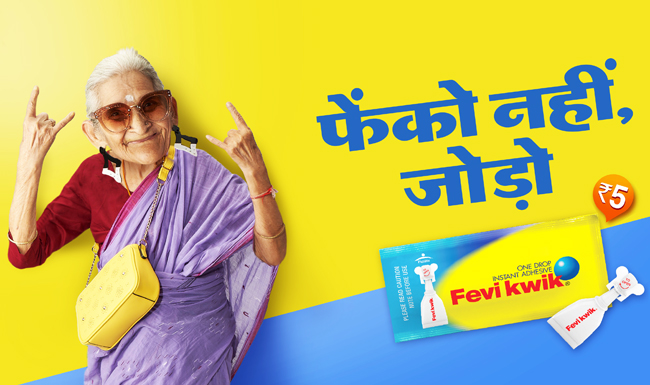Shake but don’t stir your strategy, recommends the brandgym’s Remona Duquesne.
Earlier this year, in anticipation of the upcoming James Bond flick set for mid-2020, we watched one of the classics, ‘The Spy Who Loved Me’, at a company retreat. Ten minutes in, our emotions were mixed: equal parts amusement and shock at the highly inappropriate dialogue! Yet ‘Brand Bond’ remains one of the most successful entertainment franchises in the world: still famous for being action-packed with plenty of twists and turns. If the movie we had just watched was any gauge, how could this be?
While ‘The Spy Who Loved Me’ may not resonate today, it was a big hit in the 70s, and Bond movies have continued to be successful. The Bond franchise has consistently remembered and refreshed what made its brand famous; what we at the brandgym call ‘fresh consistency’. Almost each Bond incarnation has managed to be ‘fresh’ for the times and stay true to the formula that makes it successful.
While many of this year’s case studies got their target audience’s attention by twisting and challenging the codes of their category, the stronger few also leveraged what made their brand famous, building true connection. After all, what’s the point of cutting through if no one can remember it’s your brand in the first place? In other words, like Bond, these brands also practised ‘fresh consistency’.
- Fresh: New and exciting things to keep the brand story current and up-to-date.
- Consistency: Tried-and-tested elements that people remember and love that build brand fame.
‘Fresh consistency’ in practice
The Tang Gets It Done case study shows ‘fresh consistency’ in practice. Faced with an 80% price mark-up as well as an unfavourable economic backdrop, the brand recognised it needed to refresh its story to survive – and managed to do so with strong results.
Tang’s DNA is about making water taste better (in the 1950s, Tang was chosen by NASA because only Tang could make poor-tasting water in spacecraft palatable for astronauts). However, in the context of a budget-crushing price increase, the brand needed to find a way to elevate this benefit to justify its price premium. After discovering that most of its target market, Filipino kids aged 8-12, are under-hydrated and that mums struggle to get them to drink plain water due to tastelessness, Tang saw an opportunity to reinvent itself from a non-essential into an enabler of daily hydration thanks to its taste.

The new brand story cleverly balances the parts of its DNA that made it famous in the first place and hence undeniably ‘Tang’ (consistency) with a true-but-unexpected creative expression that challenged category expectations (freshness). Central to the latter was a fresh insight that revealed the pressure on mums to do everything perfectly (as typically shown by brands in the category) simply doesn’t work in the real world, and Filipino mums were tired of this depiction. So instead of ‘perfect mum’ as the protagonist, which was the norm, the new Tang heroine is an imperfect ‘realpolitik mum’ who gets things done in her own real but unconventional way.
Activating ‘fresh consistency’
A useful tool to assess and activate ‘fresh consistency’ is via a Brand Renovation Brief which captures what to Keep (consistency) and what to Update/Lose/Add (freshness), as demonstrated in the illustrative Bond and Tang examples below:

Knowing what to keep, update, lose and add comes from one place: fresh insight – from consumers, customers, culture, category, communications, or the brand itself.
Audit your assets
A great way to draw out which brand properties to keep or lose, is via an ‘Iconic Asset Tracker’ (IcAT). This study helps brand owners make data-based decisions about which brand properties are distinctive to a brand, highlighting the iconic assets (which could be a logo, a sound, an image etc.) that are truly embedded in memory structures, as opposed to those recalled only after having thought about it. It also identifies the weak links.
Or, you could conduct a ‘brand archaeology’ exercise by looking back at what made the brand famous. You could dig into the brand’s past marketing mix for example – when was the brand ‘hot’, growing share and sales, and when it was ‘cold’? What was the brand doing at these times, both in terms of brand promise and brand properties? Many gems can be unearthed in such an exercise – like Tang’s NASA origins – that are both distinctive to the brand yet unique enough to disrupt category norms, unlocking new opportunities for growth.
Twist the category
Closer to the ‘category twist’ theme from this year’s papers, is the ‘freshness’ side of ‘fresh consistency’: identifying what to update or add to the brand story or campaign. This involves looking forward at how the world is changing through investigating emerging codes and trends in culture. For example, Tang clearly saw it was high time to update its unrealistic ‘perfect mum stereotype’ with a more imperfect, yet true-to-life mum.
Another example comes from Fevikwik, India’s undisputed leader in instant adhesives, that identified 18- to 35-year-olds as its growth market. Unfortunately, this group believes ‘buying is better than repairing’ because consumption is a ‘mark of life’s upgradation’. Fortunately for Fevikwik, for every trend there’s a countertrend and the latter led to ‘stupid people discard, smart people repair’, which became the insight behind its successful campaign.

Crush the category clichés
To create a category twist, you need to know the codes of the category. In its Only True Fans Get It campaign, Singtel took it one step further and identified the category’s clichés… and used them to its advantage. Singtel was faced with winning over new customers with absolutely zero product differentiation vs. anyone else who had an EPL package to sell. To stand out, it pretended to behave just like any other EPL ad – the winning goal, the roaring fans, the star player – only it wasn’t. Singtel deliberately made mistakes in its ad to draw out true EPL fans, then made a brilliant and brave social campaign out of it.
A final note
Whilst many of the submitted cases demonstrated some level of cut-through and others were clearly on-brand, it’s more those that cleverly balanced freshness with brand consistency that tended to make the shortlist. The WARC Prize for Asian Strategy is meant to recognise Asia’s smartest marketing thinking, and while it’s key to ensure there’s enough ‘freshness’ to keep a brand exciting and current, it’s only smart if people remember it’s your brand that cuts through.
An abridged version of this article appears in WARC’s 2020 Asian Strategy Report.

